Achieves Highest Tow Ever As Campaign Continues
The Perlan 2 glider reached another milestone last week, achieving its highest tow ever during a flight August 28th. The aircraft reached an altitude of 46,700 above sea level pressure altitude before being released by the tow plane.

Perlan team member Dr. Daniel Johnson writes on Facebook that the record was achieved because the airplane-glider tandem climbed slowly as it wandered all over the sky looking for workable wave lift that could bring the glider into the predicted strong wave high above. They did not find satisfactory lift. After release, the glider only gained about 800 feet.
Takeoff was shortly after noon, landing shortly before 4 pm. Perlan 2 now has flown 60 times, totaling 127 hours. This was a useful test flight.
22 pounds (10 kg) were added to the tail, and this resulted in a CG (center of aircraft gravity) that was just about perfect.
What does "perfect" mean? An aircraft must be somewhat nose-heavy, so that if it stalls, it will fall nose-first so that forward speed will increase and wing lift and pilot control regained as quickly as possible. This means that there is always a downward force produced by the tail in order to have level or climbing flight. That downward force is produced by the horizontal tail and elevator. The elevator's angle is changed by pushing or pulling on the control stick to change the angle of the wings and aircraft.
Increasing the elevator's angle makes the wind flowing past bend more, which increases the wind's speed. Close to the speed of sound -- as the Perlan will be at its maximum designed altitude -- the bent wind may develop an angle in its flow (and "shock wave") that abruptly changes the force holding the nose up. The pilot will feel this as a change in the force needed to hold the nose attitude, but the change can possibly be outside the limits of control.
Johnson says that Team Perlan, specifically Morgan Sandercock, an inventive and brilliant engineer, created a new system of sensors showing very precisely the angle of each control surface, so that pilots can understand exactly the position of each control surface.
It was calculated that changing the position of the Perlan glider's center of gravity by adding tail weight would allow the elevator to require minimal deflection at its normal speed of 48 knots indicated near its maximum altitude of about 90,000 ft.
This does two good things:
- Decreases the bending of the wind with control changes, thereby decreasing the risk of a shock wave.
- And decreases the force needed by the pilot to keep the glider's attitude steady.

This flight showed that the elevator position and control force is exactly what was desired.
Measures were taken since last season to combat the frosting of windows. Dry air can be fed to a window plenum. This greatly decreased frost, and had a useful side effect in that the air needed to feed the plenums was just about enough to balance the slight leakage of air from the cockpit.
Last season, the tire lost air in the cold, meaning Jim had to land on a flattish tire in gusty winds. Many changes were made, and today the tire was well inflated after landing.
(Images from Facebook)
 Classic Aero-TV: In Praise of Alabamas Patriot Aircraft USA
Classic Aero-TV: In Praise of Alabamas Patriot Aircraft USA NTSB Final Report: Cirrus Design Corp SR22
NTSB Final Report: Cirrus Design Corp SR22 ANN's Daily Aero-Term (12.21.25): Dead Reckoning
ANN's Daily Aero-Term (12.21.25): Dead Reckoning ANN's Daily Aero-Linx (12.21.25)
ANN's Daily Aero-Linx (12.21.25) Aero-News: Quote of the Day (12.21.25)
Aero-News: Quote of the Day (12.21.25)




